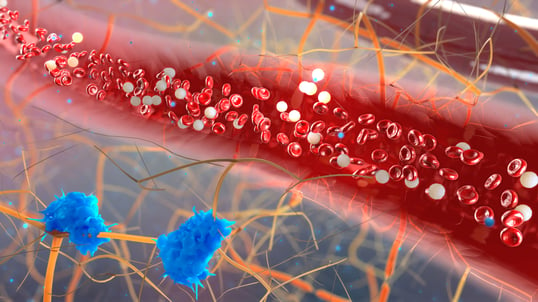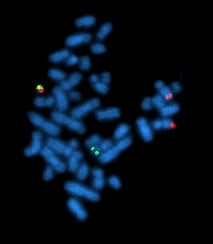Myeloid cancers are “liquid” tumors that arise from the blood and bone marrow. These diseases have undergone greater study and characterization than perhaps any other type of cancer, largely due to the ease of accessing these cancer cells via a blood draw rather than a tissue biopsy, as for solid tumors. There are many different types and subtypes of these malignancies that are known to be caused by mutations in genes that encode proteins involved in cell signaling, transcription, epigenetic regulation, and splicing1.

Before next-generation sequencing became available in the hematology/oncology clinic, high-resolution genetic analysis of myeloid cancers relied primarily upon site-specific methods such as Fluorescence in Situ Hybridization (FISH) and PCR-based assays. And, while other methods such as karyotyping and array comparative genomic hybridization are indeed able to survey large genomic rearrangements and copy number changes across the entire genome, these methods lack the resolution required for detection of many mutations that are important for myeloid cancers.

Image courtesy of https://en.wikipedia.org/wiki/Fluorescence_in_situ_hybridization
FISH assay showing cell positive for BCR-ABL fusion, which is present in 95% of cases of chronic myeloid leukemia.
It is no surprise, then, that as NGS technologies have dramatically improved, and have gained an undeniable foothold in the clinical oncology space with recent FDA approvals of several NGS-based diagnostic assays2,3,4 there is an increasing number of NGS tests available for genomic profiling of hematologic malignancies. The ability to interrogate a broad panel of targets at high resolution makes NGS a very appealing option, with the potential to help molecular diagnosis and disease classification, as well as predict disease outcome, faster and more effectively than ever before. Additionally, NGS can also enable development of novel medicines targeted against specific genetic lesions that occur across these cancers.
Because there is such a vast diversity of mutations across many different genes that are relevant for myeloid cancers, and many of these variants carry defined clinical significance that may be used to guide patient care5, it is vital for clinical laboratories running these comprehensive NGS tests to conduct thorough validations prior to patient testing. Unfortunately, this is a challenge since no reference materials have been available that are designed specifically for NGS myeloid assays – as a result, labs have either been limited in their ability to validate their myeloid cancer tests, or have relied on residual patient samples and individual cell lines to try and cover as many relevant targets as possible. Validating assay performance one mutation at a time is a drawn-out and costly exercise when panel content must range from simple single-nucleotide variants to FLT3 internal tandem duplications and mutations in difficult genes such as CEBPA.
USCS genome browser view of CEBPA, a transcription factor that plays a role in differentiation of blood cells. Note the high GC content along this gene’s only exon, which can present challenges for certain assays.
Image courtesy of Kent WJ, Sugnet CW, Furey TS, Roskin KM, Pringle TH, Zahler AM, Haussler D.
The human genome browser at UCSC. Genome Res. 2002 Jun;12(6):996-1006.
To help labs who are bringing NGS tests for myeloid cancers to the clinic, SeraCare has designed a set of highly multiplexed reference materials that can greatly reduce the burden of having to establish, evaluate, and maintain the performance of these assays. Seraseq™ Myeloid Mutation DNA Mix and Seraseq™ Myeloid Fusion RNA Mix contain DNA sequence mutations and RNA fusions that have been characterized across diseases such as acute and chronic myeloid leukemia, and they are able to offer a wealth of data around assay performance, in a single run.
As an example of how these materials could be used, consider a clinical heme/onc lab in the process of fulfilling New York State Department of Health’s (NYSDOH) full validation requirements for NGS-based somatic genetic variant detection (pdf). Full validation requires 10 positive samples per variant type, per target area.
Variant types in these guidelines include:
- SNVs
- Indels
- CNVs
- Translocations
- Novel variant types
Examples of target areas are genes or particular fusion partners. New York State guidelines specify that for SNVs and indels, a minimum of 20 target areas each must be validated, while for translocations, 3 confirmations are required for each fusion partner targeted by the assay. In short, meeting the NYSDOH full validation requirements for a myeloid cancer NGS test requires a significant number of assay and/or confirmatory (if in production after an initial validation) runs.
In the same context, consider that a single run of Seraseq Myeloid Mutation DNA Mix is able to yield data for:
- 23 total positive calls
- 13 SNVs across 11 different genes (target areas)
- 4 insertions across 3 different genes
- 4 deletions across 4 different genes
- 2 novel variant types (internal tandem duplications)
Likewise, a single run for Seraseq Fusion RNA Mix would offer data for:
- 9 total positive calls for translocations across 7 different fusion partners
To generate data equivalent to those yielded across two runs of the Seraseq myeloid reference materials, laboratories relying on residual patient specimens and single-plex cell lines would have to source, manage, and run 32 individual samples (one variant per sample for each of the 23 DNA and 9 RNA variants). In addition to costs associated with an ad hoc bio banking project, assuming an average run cost of $150 per sample, running all of the individual positives would amount to $4,800 ($150 x 32) in incremental running costs versus $300 ($150 x 2) to test both of SeraCare’s highly multiplexed myeloid reference materials. Certainly, Seraseq materials are not intended to stand alone as a sample set for an activity as complex as a NYSDOH validation; however, they definitely enable labs to better understand assay performance characteristics across challenging scenarios that will be encountered “in the wild”.
Get in touch today and tell us whether you are developing, validating, or are in production for your NGS myeloid assay to get started with Seraseq myeloid reference materials. Also stay tuned for our next post on the many clinically-relevant targets we included in the design of these products.
References
- Murati A et al. “Myeloid malignancies: mutations, models and management.” BMC Cancer 2012 12:304, doi: https://doi.org/10.1186/1471-2407-12-304. Accessed 26 Sep 2017.
- Summary of Safety and Effectiveness Data, Oncomine™ Dx Target Test: https://www.accessdata.fda.gov/cdrh_docs/pdf16/p160045b.pdf
- Summary of Safety and Effectiveness Data, Praxis™ Extended RAS Panel:
https://www.accessdata.fda.gov/cdrh_docs/pdf16/P160038B.pdf - Summary of Safety and Effectiveness Data, FoundationFocus™ CDxBRCA:
https://www.accessdata.fda.gov/cdrh_docs/pdf16/P160018B.pdf - Arber D et al. “The 2016 revision to the World Health Organization classification of myeloid neoplasms and acute leukemia.” Blood 2016 127:2391-2405, doi: https://doi.org/10.1182/blood-2016-03-643544. Accessed 26 Sep 2017.





